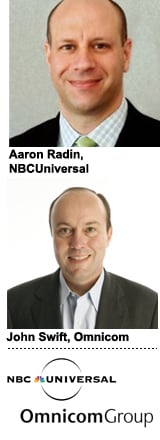 NBCUniversal transacted 10-15% of its digital business programmatically during the 2015-2016 season, the company has revealed to AdExchanger.
NBCUniversal transacted 10-15% of its digital business programmatically during the 2015-2016 season, the company has revealed to AdExchanger.
Prior to the upfronts, the company expected to secure 50% of commitments on a “converged” basis, with elements of both TV and digital in a single deal. In this most recent upfront, NBCUniversal’s digital business grew 50% and, of that growth, programmatic represented 40%.
“We had been very active previously with our programmatic offering principally around display, but we wanted to evaluate how we could balance audience targeting at scale against premium content for our clients with video,” said Aaron Radin, SVP of partnerships and portfolio products for NBCUniversal.
Agency clients wanted deeper automation and more of a “portfolio” buy across all NBCU properties, Radin said.
NBC made marked efforts to unite its portfolio opportunities when it launched private exchange NBCUx last fall, which amassed audiences across news, entertainment, sports and Hispanic verticals.
Omnicom Group buys video, mobile and display formats programmatically through NBCUx in addition to its larger TV sponsorships and brand integrations for its clients.
It creates custom segments for clients by connecting its data-management platform, Annalect, to NBC’s Audience Targeting Platform (ATP), combining first- and third-party data with viewership habits.
“We’re moving toward a place where addressability becomes real and scalable,” said John Swift, CEO of North American investment for Omnicom. “There have been a lot of middleware companies out there who offer up some sort of addressability, but scale has been the main issue.”
NBCUniversal’s offering is one of the most vertically integrated media opportunities combining data, content and audience targeting across TV and digital, he claimed.NBCUniversal reached an important milestone last May, when it began to integrate anonymized Comcast set-top box data into ATP, commingling over-the-top viewership data with NBC first-party and third-party data sets. The process is ongoing.
“We’re being very aggressive in introducing products that allow clients to scale in reaching target audiences across all screens,” Radin said. “NBCUx represents audiences on a digital basis, ATP represents it on a linear basis and Social Sync does it across social. There are, of course, legacies of the business that will evolve over time, but the goal is to reach audiences irrespective of screen.”
Data was a hallmark of the 2015-2016 upfronts and of NBC’s rollout of offerings like ATP, but some buyers claimed networks used proprietary audience targeting as a bargaining chip to negotiate higher CPMs.
Not necessarily so, said Swift, who added that digital and broadcast sellers are beginning to tip the scale in their respective specialties.
Traditionally, TV lacked the data targeting precision of digital while digital, conversely, played second fiddle to broadcast in terms of splashy or original, premium content. That’s changing.
NBCUniversal’s recent investments in new media publishers Vox and BuzzFeed, as well as content syndication agreements with Verizon and AOL, point to its pursuit of convergence.
While digital, mobile and other growth drivers such as video on demand are additive to NBC’s overall business, the concept of the upfront is not going away anytime soon.
“We have very significant commitments from other clients through our legacy business, but scarcity begets a model like the upfronts and we hang our hat on the differentiation of our product in terms of volume, quality and scale,” Radin said. “In that sense, it is a scarce resource, requiring some level of commitment in order to get some position within that inventory.”













